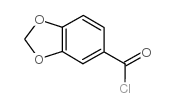Piperonyloyl chloride

Piperonyloyl chloride structure
|
Common Name | Piperonyloyl chloride | ||
|---|---|---|---|---|
| CAS Number | 25054-53-9 | Molecular Weight | 184.57600 | |
| Density | 1.453 g/cm3 | Boiling Point | 155 °C25 mm Hg(lit.) | |
| Molecular Formula | C8H5ClO3 | Melting Point | 78-79 °C(lit.) | |
| MSDS | Chinese USA | Flash Point | 130.1ºC | |
| Symbol |

GHS05 |
Signal Word | Danger | |
|
Concise Synthetic Approaches to Naturally Occurring ß-Hydroxypyranochalcones: First Total Synthesis of Purpurenone, Its Derivative, and Praecansone B. Wang X, et al.
Bull. Korean Chem. Soc. 33(8) , 2647-2650., (2012)
|
|
|
Studies on the Piscicidal Components of Justicia Hayatai var. decumbens. OHTA K, et al.
Agric. Biol. Chem. 33(4) , 610-14, (1969)
|
|
|
Correlation of the Rates of Solvolysis of Electron-Rich Benzoyl Chloride Using the Extended Grunwald-Wistein Equation. Oh H, et al.
Bull. Korean Chem. Soc. 34(9) , 2697, (2013)
|
|
|
Pelletier SW.
Alkaloids: Chemical and Biological Perspectives, Volume 14 , (2000) 14 , 441-442
|
|
|
Structure-activity relationship studies on unifiram (DM232) and sunifiram (DM235), two novel and potent cognition enhancing drugs.
Bioorg. Med. Chem. 12(1) , 71-85, (2004) Structure-activity relationships on two novel potent cognition enhancing drugs, unifiram (DM232, 1) and sunifiram (DM235, 2), are reported. Although none of the compounds synthesised reached the potency of the parent drugs, some fairly active compounds have b... |
|
|
Synthesis and antitumour evaluation of novel 2-phenylbenzimidazoles.
J. Enzyme Inhib. Med. Chem. 23(5) , 641-47, (2008) A new series of fluorinated and non-fluorinated 2-phenylbenzimidazoles bearing oxygenated substituents on the phenyl ring has been synthesized. Synthesis of the new series was based on our previous discovery of 2-(3,4-dimethoxyphenyl)-5-fluorobenzothiazole (P... |
|
|
Synthesis of novel IP agonists via N-aminoethyl cyclic amines prepared by decarboxylative ring-opening reactions.
Molecules 17(2) , 1233-46, (2012) An efficient synthesis of a highly potent and selective IP (PGI(2) receptor) agonist that is not structurally analogous to PGI(2) is described. This synthesis is accomplished through the following key steps: Nucleophilic ring-opening of 3-(4-chlorophenyl)-oxa... |